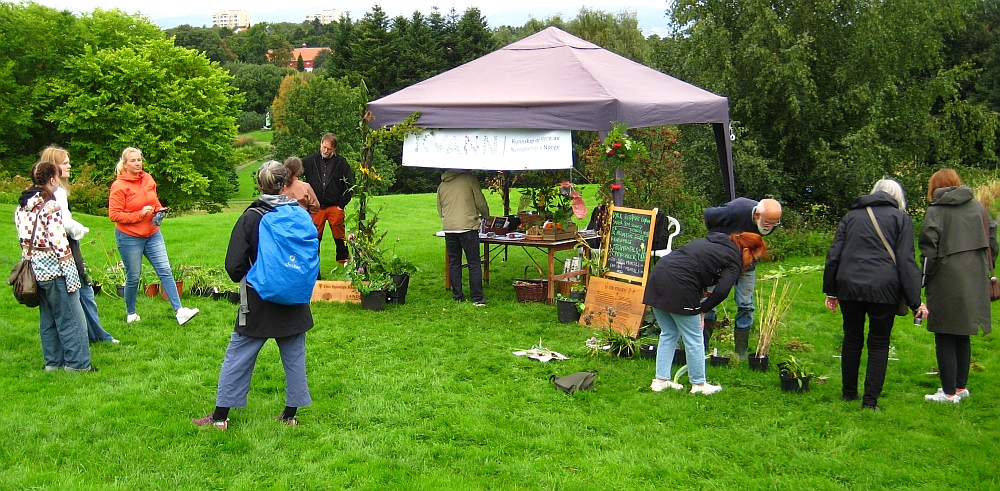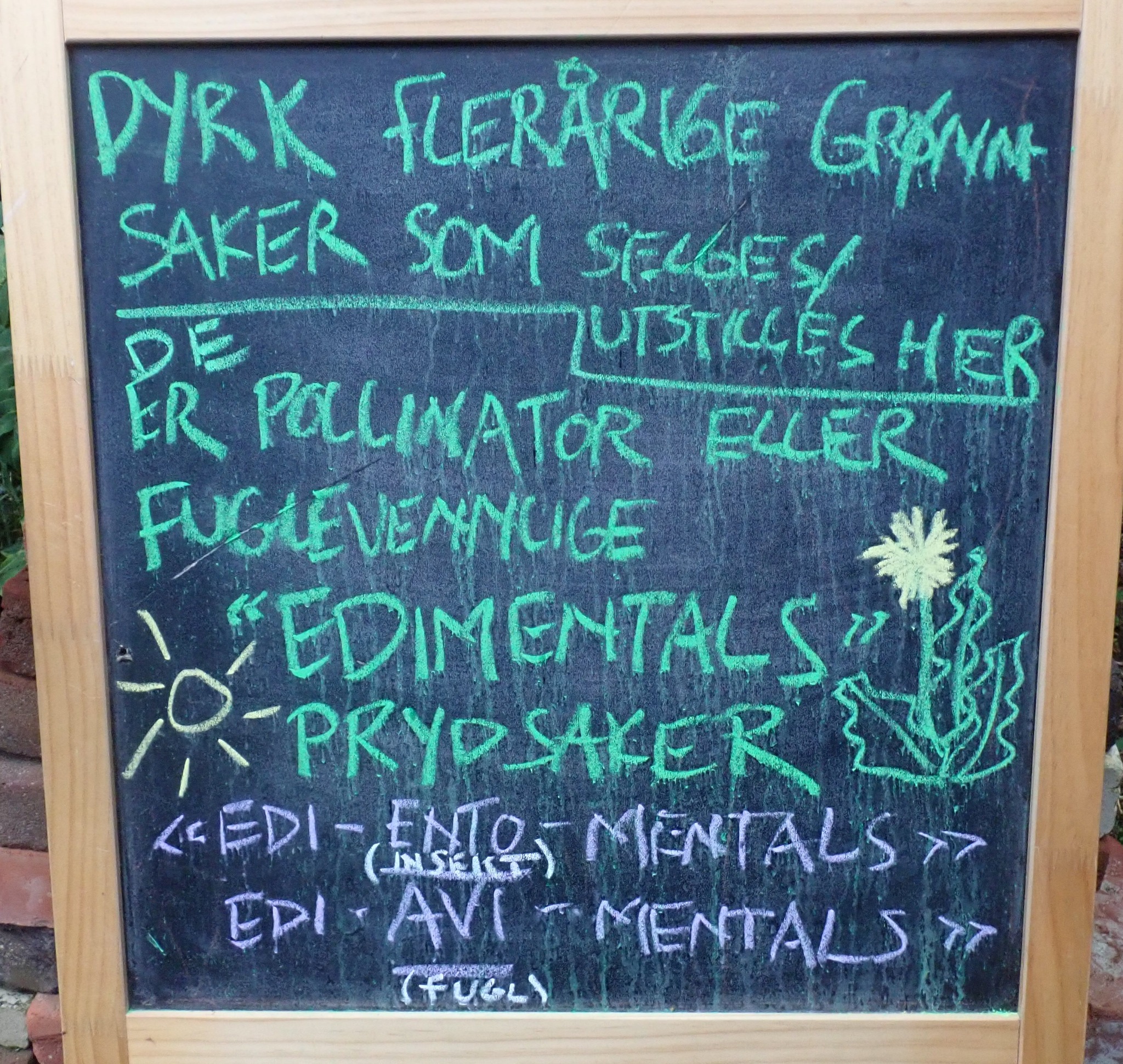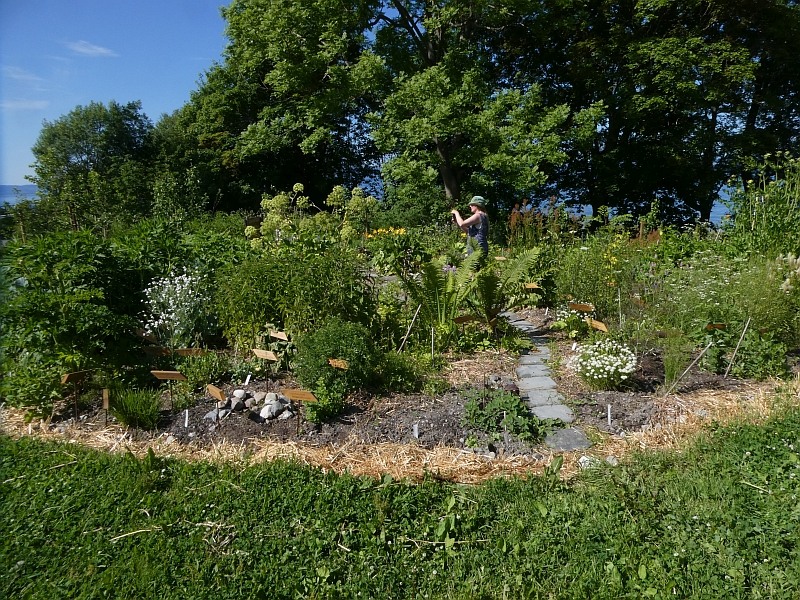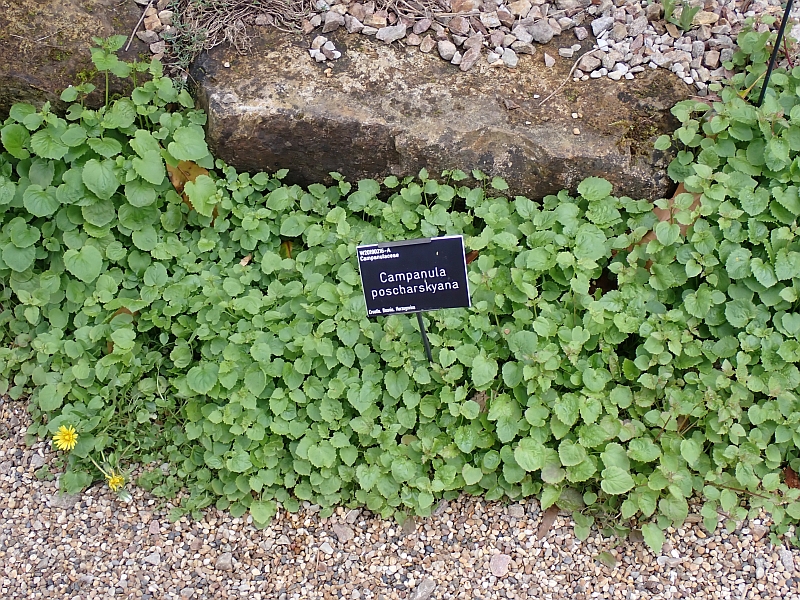To celebrate 40 years since I and my then wife Eileen bought Bergstua (literally house on the rock) and the garden that became The Edible (Forest) Garden, I endeavoured during the second of the two garden tours (as part of økouka – organics week) to talk about 40 of the plants in the garden during the 90 minute tour (see below)…and underway I discovered two firsts for the garden! Next time I must do an Around the Garden in 80 plants tour (it’s soon the 10th anniversary of my book!)….but would anyone come to a 3 hour tour?
Curious about what plants I talked about on this mid-September day, then scroll down as I list and have added notes about all 40!
…and another lovely group of participants took part on this special Saturday garden tour:
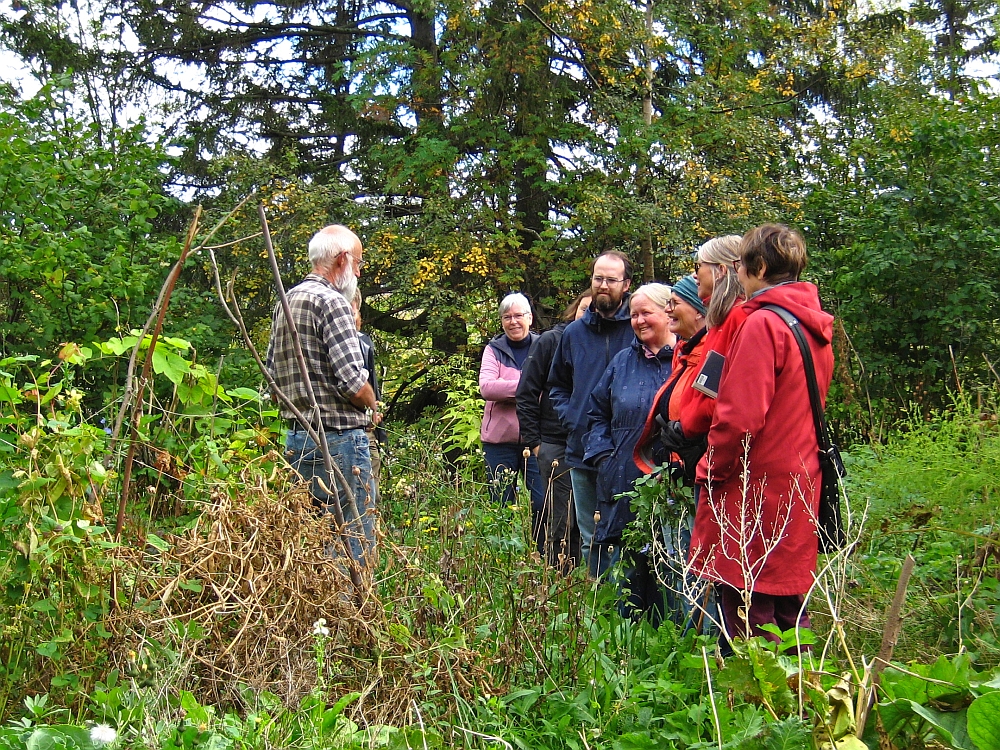
Here are the plants and subjects I talked about:
1. Urtica dioica, stinging nettle / brennesle and plant #1 for biodiversity in the garden: 60+ moth and butterfly larvae feed on this plant and various birds like bullfinch and redpoll (dompap og gråsisik) feed on the seeds in winter; I don’t cut down this patch in good view of the kitchen window for winter bird watching:
 2. Urtica gracilis, California nettle, slender nettle is considered a subspecies of dioica and reaches over 3m in my garden on dry soil:
2. Urtica gracilis, California nettle, slender nettle is considered a subspecies of dioica and reaches over 3m in my garden on dry soil:
 3. Salix caprea, goat willow / selje; even though not edible for us, it’s another key species for biodiversity important for wild bees, bumble bees and other insects, including 60 moths feeding on the catkins in mid-April and as a larval food plants and in turn for insectivorous birds, many of which like the chiffchaff (gransanger) arrive as the flowers open. I have several large trees in the garden:
3. Salix caprea, goat willow / selje; even though not edible for us, it’s another key species for biodiversity important for wild bees, bumble bees and other insects, including 60 moths feeding on the catkins in mid-April and as a larval food plants and in turn for insectivorous birds, many of which like the chiffchaff (gransanger) arrive as the flowers open. I have several large trees in the garden: 4. Vicia faba, broad beans / bondebønner; the authorities recommend that we eat more climate friendly / healthy vegetarian and vegan foods, yet much of this food is imported. Broad (fava) beans were the original hummus / felafel bean and we should be growing them in a big way, even here along the Trondheimsfjord where I live; this is the diverse local grex I’ve developed here, currently drying for seed and winter dishes:
4. Vicia faba, broad beans / bondebønner; the authorities recommend that we eat more climate friendly / healthy vegetarian and vegan foods, yet much of this food is imported. Broad (fava) beans were the original hummus / felafel bean and we should be growing them in a big way, even here along the Trondheimsfjord where I live; this is the diverse local grex I’ve developed here, currently drying for seed and winter dishes: 5. Phaseolus coccineus, runner beans / løpebønner; I’m also developing a local early land race that produces ripe beans here:
5. Phaseolus coccineus, runner beans / løpebønner; I’m also developing a local early land race that produces ripe beans here: 6. Cichorium intybus, chicory / sikori; one of my favourite vegetables with bitterness lacking in modern diets. It’s a versatile vegetable and salad crop with hundreds of varieties that I’m trialling; is easy to save seed from and when in flower in late summer is loved by hoverflies – I also have perennial plants that have naturalised here:
6. Cichorium intybus, chicory / sikori; one of my favourite vegetables with bitterness lacking in modern diets. It’s a versatile vegetable and salad crop with hundreds of varieties that I’m trialling; is easy to save seed from and when in flower in late summer is loved by hoverflies – I also have perennial plants that have naturalised here:
 7. Allium cernuum, nodding or Chicago onion / prærieløk is probably my favourite and most used perennial onion; it’s super-hardy, can be harvested all winter, tolerates also heat and drought, is a fast grower and is one of the best edientomentals (edible, pollinator friendly and ornamental):
7. Allium cernuum, nodding or Chicago onion / prærieløk is probably my favourite and most used perennial onion; it’s super-hardy, can be harvested all winter, tolerates also heat and drought, is a fast grower and is one of the best edientomentals (edible, pollinator friendly and ornamental):
 8. Allium wallichii, Sherpa or Nepal onion / Sherpaløk; see my book and search on this blog for much more about this great Allium; I talked about the pleasure of the Nepalese botanist and his wife who visited my garden and met this onion (Jimmu) for the first time, despite having eaten it all their lives – they had never been to the high elevations where this plant grows and is grown for markets, destined for lentil soup.
8. Allium wallichii, Sherpa or Nepal onion / Sherpaløk; see my book and search on this blog for much more about this great Allium; I talked about the pleasure of the Nepalese botanist and his wife who visited my garden and met this onion (Jimmu) for the first time, despite having eaten it all their lives – they had never been to the high elevations where this plant grows and is grown for markets, destined for lentil soup.
9. Allium stipitatum, Persian shallot is one of the ornamental onions that are commonly sold in garden centres in autumn; they are productive, quickly multiplying here. They are used in the Iranian national dish yogurt and Persian shallot dip (Mast-o Mooseer) and often spiced up with the delicious ground seeds of Tromsø-palm (Heracleum persicum) or golpar! I showed both the spice and seeds of another Heracleum species that we use daily in various dishes, replacing cumin. 10. Heracleum sphondylium, hogweed / kystbjørnekjeks: probably the most important plant in the garden for a wide range of pollinators – several rare hoverflies, wasps and wild bees have turned up in the umbels; it also flowers over a very long period and provides me also with golpar (see #9) and delicious spring shoots. It’s flowered this year continuously in the garden from June this year:
10. Heracleum sphondylium, hogweed / kystbjørnekjeks: probably the most important plant in the garden for a wide range of pollinators – several rare hoverflies, wasps and wild bees have turned up in the umbels; it also flowers over a very long period and provides me also with golpar (see #9) and delicious spring shoots. It’s flowered this year continuously in the garden from June this year:
 11. Allium victorialis, victory onion / seiersløk; see my book and search the web site for more information. Another great edientomental!
11. Allium victorialis, victory onion / seiersløk; see my book and search the web site for more information. Another great edientomental!
12. Hosta sieboldiana “Big Daddy”; the perennial vegetable that really shows the benefits, attractive, tasty plants that can be grown in places like the shady, north side of your house where you wouldn’t dream of growing annuals, never need irrigation, may well outlive you and are, surprisingly, very nutritious and productive. Cultivated as sansai vegetables in a big way in the mountains in Japan. See my book and search this web page for much more.  13. Malva moschata, musk mallow / moskuskattost is my favourite Malvaceae; can be used throughout the summer (flowers and young seed pods can also be eaten).
13. Malva moschata, musk mallow / moskuskattost is my favourite Malvaceae; can be used throughout the summer (flowers and young seed pods can also be eaten).
14.Malva alcea, hollyhock mallow / rosekattost; as Malva moschata
15-16. Aster scaber and Aster yomena are two tall autumn flowering species currently brightening up the garden; the former is a very important cultivated pring vegetable in Korea (see more in my book), the latter is wild foraged in Japan: 17. Rudbeckia laciniata, Cherokee spinach, sochan / kyss-meg -over-gjerde, gjerdesolhatt; perhaps the most commonly grown ornamental in Norwegian gardens since 1900 is the most important vegetable for the Cherokee people of the Appalachian mountains; is now being cultivated commercially in Korea.
17. Rudbeckia laciniata, Cherokee spinach, sochan / kyss-meg -over-gjerde, gjerdesolhatt; perhaps the most commonly grown ornamental in Norwegian gardens since 1900 is the most important vegetable for the Cherokee people of the Appalachian mountains; is now being cultivated commercially in Korea.
 18. Vitis coignetiae, crimson glory vine, Japanvin (can be seen in the background of the picture above); the grapes are small and my plant hasn’t produced any – leaves can be used as wraps.
18. Vitis coignetiae, crimson glory vine, Japanvin (can be seen in the background of the picture above); the grapes are small and my plant hasn’t produced any – leaves can be used as wraps.
19. Ligularia fischeri; gomchwi, Korea-nøkketunge; an important cultivated vegetable in Korea (king of the sannamul or mountain vegetables). More on my web site.
20. Dahlia, georginer; came to Europe originally as a tuber crop but was outcompeted by potato.
 21. Secale “Mountaineer”, perennial rye / flerårige rug: we talked about the benefits of perennial grains which can give large savings in fuel, watering and fertiliser as with all perennial crops (both perennial barley and wheat have also been created but developments are slow)
21. Secale “Mountaineer”, perennial rye / flerårige rug: we talked about the benefits of perennial grains which can give large savings in fuel, watering and fertiliser as with all perennial crops (both perennial barley and wheat have also been created but developments are slow) 22. Solanum lycopersicum, tomato / tomat; we talked about two varieties (shown in the picture) that I’d recently harvested: large German Pink was the first edible to be saved and offered through Seed Savers Exchange in 1973. I was gifted seed through SSE when I visited in 2019 and it is now greenhouse grown by several in KVANN (Norwegian Seed Savers); mine were grown indoors. The smaller tomato is probably the best early, cold tolerant variety I’ve grown (starting with 10 varieties 3 years ago, these along with 42 days and Turbo Reaktniy ripened outside in mid-August).
22. Solanum lycopersicum, tomato / tomat; we talked about two varieties (shown in the picture) that I’d recently harvested: large German Pink was the first edible to be saved and offered through Seed Savers Exchange in 1973. I was gifted seed through SSE when I visited in 2019 and it is now greenhouse grown by several in KVANN (Norwegian Seed Savers); mine were grown indoors. The smaller tomato is probably the best early, cold tolerant variety I’ve grown (starting with 10 varieties 3 years ago, these along with 42 days and Turbo Reaktniy ripened outside in mid-August). 23. Fagopyrum tataricum, tartary buckwheat / vill bokhvete; I collect the seed which are used to produce buckwheat sprouts in winter in the living room; I’m also trying different varieties looking for best varieties for popping!
23. Fagopyrum tataricum, tartary buckwheat / vill bokhvete; I collect the seed which are used to produce buckwheat sprouts in winter in the living room; I’m also trying different varieties looking for best varieties for popping!
24. Fagopyrum acutatum, perennial buckwheat / flerårige bokhvete; used as a vegetable rather than a grain plant.
25. Campanula rapunculoides, creeping bellflower / ugressklokke; this is the only flowering bellflower at the moment, but isn’t the best edible bellflower – my favourite is giant bellflower / storklokke Campanula latifolia which has a long history of use in Norway, in particular, the sami people in the south and, historically, also Norwegians in my area harvested leaves to use in springtime soups.
26. Gunnera tinctoria is known as nalca in Chile where the leaf stems are sold on markets, used in the national dish curanto, a fish and meat stew; at this time of year the stems are rather fibrous, but can be used to quench the thirst. We sampled one of the stems and the taste was rather neutral with no sense of sweetness or sourness I’ve tasted before (participants got the quenching the thirst thing!): 27. Actinidia deliciosa, kiwi fruit; I germinated some seeds from a supermarket kiwi 30 years ago, accidentally left the resulting young plants outside all winter and they survived and are still alive today on the house wall – no chance of any fruit here as our summers are too cold and you need two compatible plants, but the one surviving plant flowers every summer.
27. Actinidia deliciosa, kiwi fruit; I germinated some seeds from a supermarket kiwi 30 years ago, accidentally left the resulting young plants outside all winter and they survived and are still alive today on the house wall – no chance of any fruit here as our summers are too cold and you need two compatible plants, but the one surviving plant flowers every summer.
 28.Staphylea pinnata, bladdernut / blærenøtt; it’s 17 years now since I planted this tree and it produces many small nuts that taste a bit like pistachios, but they are really too small to be useful. On the other hand, the young shoots and flowers are very tasty.
28.Staphylea pinnata, bladdernut / blærenøtt; it’s 17 years now since I planted this tree and it produces many small nuts that taste a bit like pistachios, but they are really too small to be useful. On the other hand, the young shoots and flowers are very tasty. 29. Taraxacum sp., dandelion / løvetann; I showed these boxes which contain 22 dandelion species which I received as seed from a dandelion specialist in the UK, all formally identified this will allow me to more easily follow and learn the ID key in the Field Handbook to British and Irish Dandelions :)
29. Taraxacum sp., dandelion / løvetann; I showed these boxes which contain 22 dandelion species which I received as seed from a dandelion specialist in the UK, all formally identified this will allow me to more easily follow and learn the ID key in the Field Handbook to British and Irish Dandelions :)  30. Hablitzia tamnoides, Caucasian spinach / stjernemelde – as usual I told the story of my favourite perennial vegetable, still after 23 years as productive as ever and reaching 3m each summer on this shady wall (more in my book and this web site); I here introduced the role of Fredrik Christian Schübeler botanical garden in Oslo in the late 1800s in our knowledge of this plant as one of the best perennial vegetables today; this also lead to my involvement in recreating Schübelers hager, a network of inspiration gardens in Norway inspired by Schübelers own network of rectory gardens to which all my 3 gardens belong; see https://kvann.no/schubeler/om-schubelers-hager:
30. Hablitzia tamnoides, Caucasian spinach / stjernemelde – as usual I told the story of my favourite perennial vegetable, still after 23 years as productive as ever and reaching 3m each summer on this shady wall (more in my book and this web site); I here introduced the role of Fredrik Christian Schübeler botanical garden in Oslo in the late 1800s in our knowledge of this plant as one of the best perennial vegetables today; this also lead to my involvement in recreating Schübelers hager, a network of inspiration gardens in Norway inspired by Schübelers own network of rectory gardens to which all my 3 gardens belong; see https://kvann.no/schubeler/om-schubelers-hager: 31. Ribes divaricatum “Worcesterberry”; all participants sampled my Worcesterberries which will hang on the bushes until the first hard frosts:
31. Ribes divaricatum “Worcesterberry”; all participants sampled my Worcesterberries which will hang on the bushes until the first hard frosts:
32. Arctium lappa, greater burdock / storborre is one of the best edi-ento-avi-mentals – edible roots and flower stems, pollinator friendly and bird friendly as well as being an attractive (interesting) plant. The plant in the picture was planted there easily seen from my living room in winter when goldfinches / stillits arrive to feed on the oil-rich seeds: 33. Scorzonera hispanica, scorzonera, scorsonerrot; the last flowers on this great long-lived perennial vegetable (much more in my book):
33. Scorzonera hispanica, scorzonera, scorsonerrot; the last flowers on this great long-lived perennial vegetable (much more in my book): 34 – 35. Aralia cordata, udo is my largest perennial veg and is seen here at 23 years old with Aroma apples (Malus domestica) in the part of the garden that is most like a mature productive forest garden with all the layers of edible plants – lesser celandine / vårkål; ground elder / strutsevinge; ostrich fern / strutsevinge; giant bellflower / storklokke; Aralia racemosa, cordata and elata; redcurrant and blackcurrant etc. and goat willow / selje towering above. Ironically, I spent a whole summer terracing above this part of the garden, the steepest and now most productive! I talked also about how the first permaculturists visiting the garden in the mid-2000s after an appearance on Norwegian TV and a 3 part article on the Edible Garden in the national gardening magazine Hagetidend, told me that I had a forest garden! The garden is now also part of the permaculture LAND Centre network.
34 – 35. Aralia cordata, udo is my largest perennial veg and is seen here at 23 years old with Aroma apples (Malus domestica) in the part of the garden that is most like a mature productive forest garden with all the layers of edible plants – lesser celandine / vårkål; ground elder / strutsevinge; ostrich fern / strutsevinge; giant bellflower / storklokke; Aralia racemosa, cordata and elata; redcurrant and blackcurrant etc. and goat willow / selje towering above. Ironically, I spent a whole summer terracing above this part of the garden, the steepest and now most productive! I talked also about how the first permaculturists visiting the garden in the mid-2000s after an appearance on Norwegian TV and a 3 part article on the Edible Garden in the national gardening magazine Hagetidend, told me that I had a forest garden! The garden is now also part of the permaculture LAND Centre network.
 36. Castanea sativa, sweet chestnut / edelkastanje; as I was showing the participants this part of the garden my eyes rested on my first sweet chestnut on a tree I planted, from woodland in Southern England, in May 2008 at 4 years old.
36. Castanea sativa, sweet chestnut / edelkastanje; as I was showing the participants this part of the garden my eyes rested on my first sweet chestnut on a tree I planted, from woodland in Southern England, in May 2008 at 4 years old. 37. Received as Juglans cathayensis , Chinese walnut / Kinesisk valnøtt (the tree is laden again this year with the chestnut seen at the far left)38. Corylus colurna, Turkish hazel / Tyrkisk hassel:
37. Received as Juglans cathayensis , Chinese walnut / Kinesisk valnøtt (the tree is laden again this year with the chestnut seen at the far left)38. Corylus colurna, Turkish hazel / Tyrkisk hassel: 39. Rhus typhina, staghorn sumac / hjortesumak (we tasted “lemonade” bush)
39. Rhus typhina, staghorn sumac / hjortesumak (we tasted “lemonade” bush) 40. Malus fusca, Oregon crabapple, Pacific crabapple; I don’t think fruits on this tree had fully ripened before and I thought the taste was quite pleasant:
40. Malus fusca, Oregon crabapple, Pacific crabapple; I don’t think fruits on this tree had fully ripened before and I thought the taste was quite pleasant: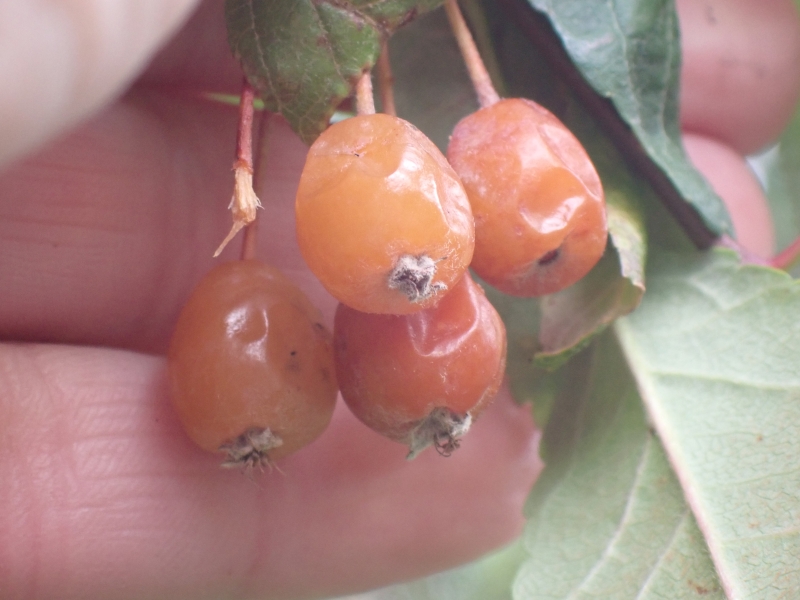
.
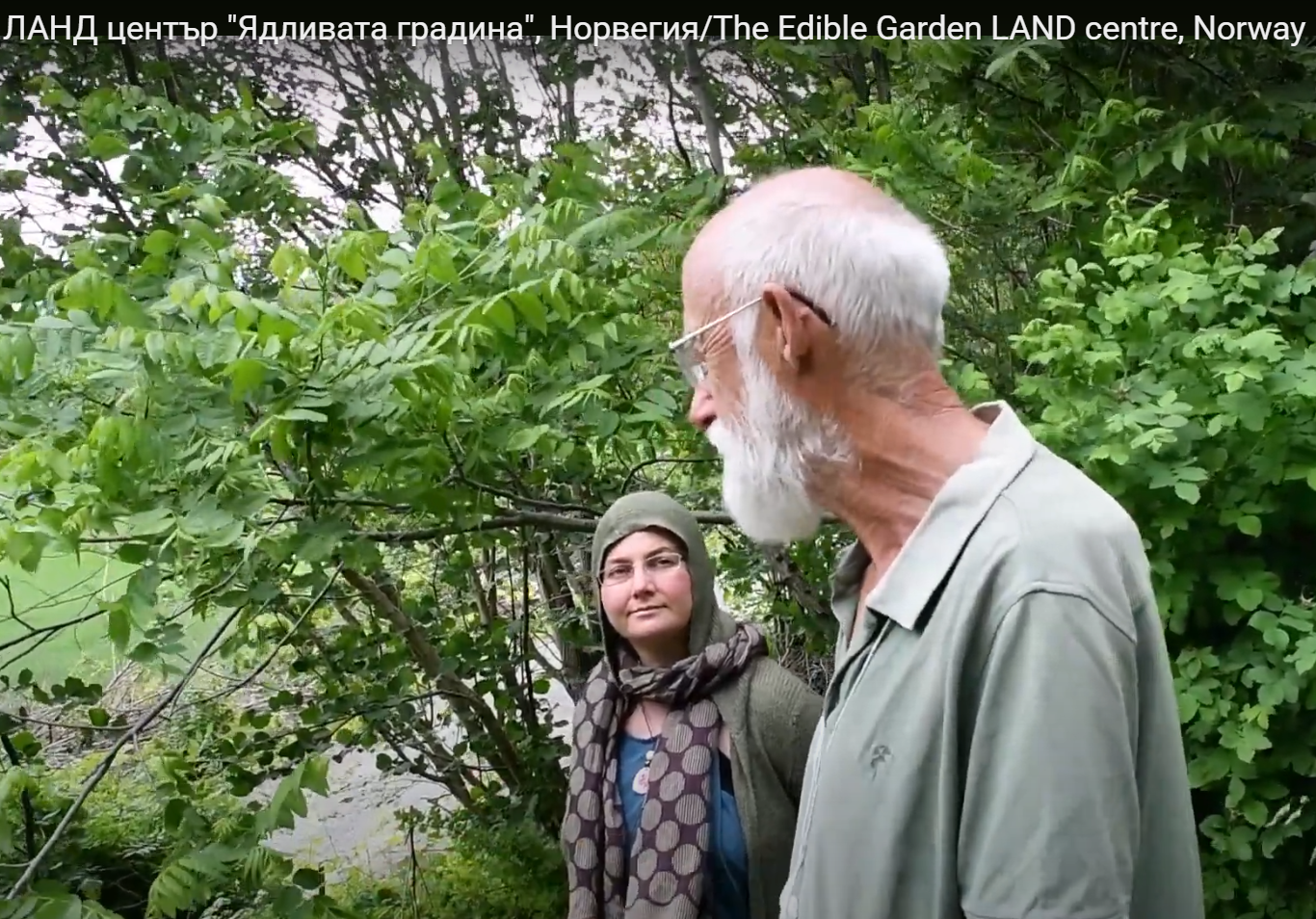





























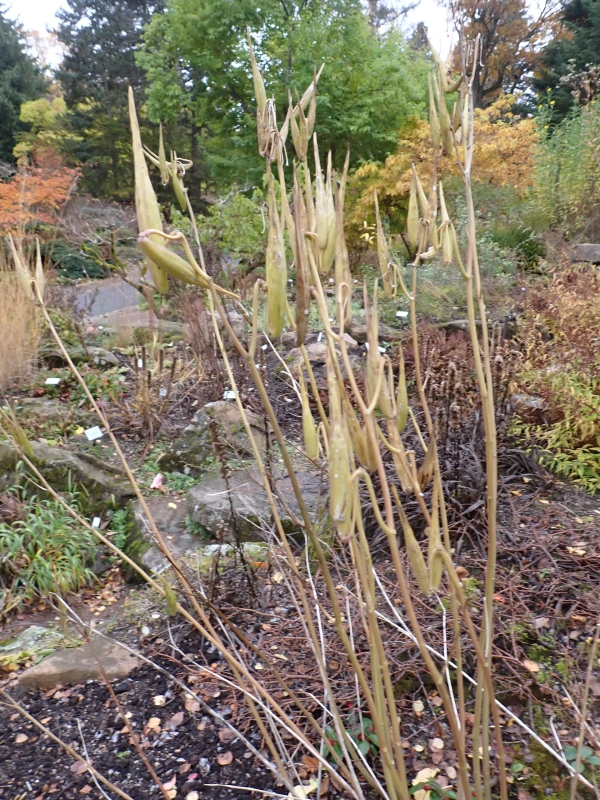









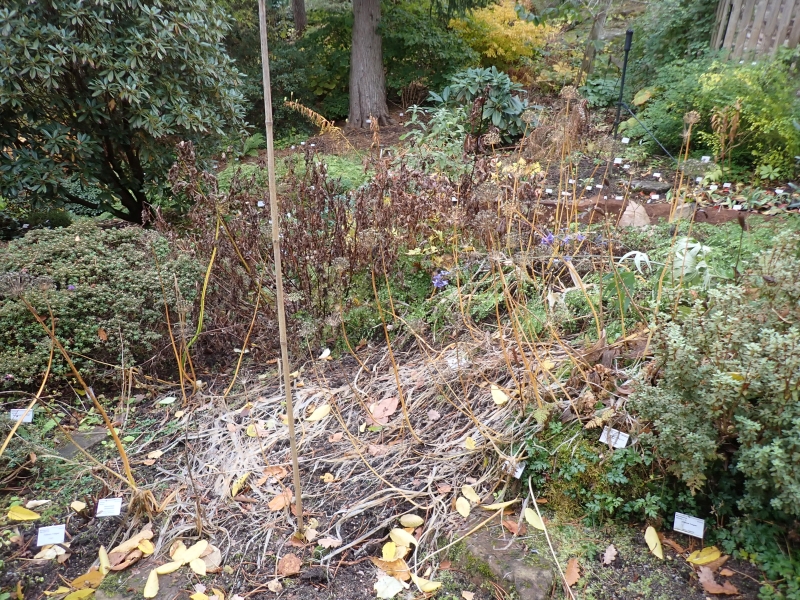


































 2. Urtica gracilis, California nettle, slender nettle is considered a subspecies of dioica and reaches over 3m in my garden on dry soil:
2. Urtica gracilis, California nettle, slender nettle is considered a subspecies of dioica and reaches over 3m in my garden on dry soil: 3. Salix caprea, goat willow / selje; even though not edible for us, it’s another key species for biodiversity important for wild bees, bumble bees and other insects, including 60 moths feeding on the catkins in mid-April and as a larval food plants and in turn for insectivorous birds, many of which like the chiffchaff (gransanger) arrive as the flowers open. I have several large trees in the garden:
3. Salix caprea, goat willow / selje; even though not edible for us, it’s another key species for biodiversity important for wild bees, bumble bees and other insects, including 60 moths feeding on the catkins in mid-April and as a larval food plants and in turn for insectivorous birds, many of which like the chiffchaff (gransanger) arrive as the flowers open. I have several large trees in the garden: 4. Vicia faba, broad beans / bondebønner; the authorities recommend that we eat more climate friendly / healthy vegetarian and vegan foods, yet much of this food is imported. Broad (fava) beans were the original hummus / felafel bean and we should be growing them in a big way, even here along the Trondheimsfjord where I live; this is the diverse local grex I’ve developed here, currently drying for seed and winter dishes:
4. Vicia faba, broad beans / bondebønner; the authorities recommend that we eat more climate friendly / healthy vegetarian and vegan foods, yet much of this food is imported. Broad (fava) beans were the original hummus / felafel bean and we should be growing them in a big way, even here along the Trondheimsfjord where I live; this is the diverse local grex I’ve developed here, currently drying for seed and winter dishes: 5. Phaseolus coccineus, runner beans / løpebønner; I’m also developing a local early land race that produces ripe beans here:
5. Phaseolus coccineus, runner beans / løpebønner; I’m also developing a local early land race that produces ripe beans here: 6. Cichorium intybus, chicory / sikori; one of my favourite vegetables with bitterness lacking in modern diets. It’s a versatile vegetable and salad crop with hundreds of varieties that I’m trialling; is easy to save seed from and when in flower in late summer is loved by hoverflies – I also have perennial plants that have naturalised here:
6. Cichorium intybus, chicory / sikori; one of my favourite vegetables with bitterness lacking in modern diets. It’s a versatile vegetable and salad crop with hundreds of varieties that I’m trialling; is easy to save seed from and when in flower in late summer is loved by hoverflies – I also have perennial plants that have naturalised here:  7. Allium cernuum, nodding or Chicago onion / prærieløk is probably my favourite and most used perennial onion; it’s super-hardy, can be harvested all winter, tolerates also heat and drought, is a fast grower and is one of the best edientomentals (edible, pollinator friendly and ornamental):
7. Allium cernuum, nodding or Chicago onion / prærieløk is probably my favourite and most used perennial onion; it’s super-hardy, can be harvested all winter, tolerates also heat and drought, is a fast grower and is one of the best edientomentals (edible, pollinator friendly and ornamental): 8. Allium wallichii, Sherpa or Nepal onion / Sherpaløk; see my book and search on this blog for much more about this great Allium; I talked about the pleasure of the Nepalese botanist and his wife who visited my garden and met this onion (Jimmu) for the first time, despite having eaten it all their lives – they had never been to the high elevations where this plant grows and is grown for markets, destined for lentil soup.
8. Allium wallichii, Sherpa or Nepal onion / Sherpaløk; see my book and search on this blog for much more about this great Allium; I talked about the pleasure of the Nepalese botanist and his wife who visited my garden and met this onion (Jimmu) for the first time, despite having eaten it all their lives – they had never been to the high elevations where this plant grows and is grown for markets, destined for lentil soup. 10. Heracleum sphondylium, hogweed / kystbjørnekjeks: probably the most important plant in the garden for a wide range of pollinators – several rare hoverflies, wasps and wild bees have turned up in the umbels; it also flowers over a very long period and provides me also with golpar (see #9) and delicious spring shoots. It’s flowered this year continuously in the garden from June this year:
10. Heracleum sphondylium, hogweed / kystbjørnekjeks: probably the most important plant in the garden for a wide range of pollinators – several rare hoverflies, wasps and wild bees have turned up in the umbels; it also flowers over a very long period and provides me also with golpar (see #9) and delicious spring shoots. It’s flowered this year continuously in the garden from June this year: 11. Allium victorialis, victory onion / seiersløk; see my book and search the web site for more information. Another great edientomental!
11. Allium victorialis, victory onion / seiersløk; see my book and search the web site for more information. Another great edientomental! 13. Malva moschata, musk mallow / moskuskattost is my favourite Malvaceae; can be used throughout the summer (flowers and young seed pods can also be eaten).
13. Malva moschata, musk mallow / moskuskattost is my favourite Malvaceae; can be used throughout the summer (flowers and young seed pods can also be eaten). 17. Rudbeckia laciniata, Cherokee spinach, sochan / kyss-meg -over-gjerde, gjerdesolhatt; perhaps the most commonly grown ornamental in Norwegian gardens since 1900 is the most important vegetable for the Cherokee people of the Appalachian mountains; is now being cultivated commercially in Korea.
17. Rudbeckia laciniata, Cherokee spinach, sochan / kyss-meg -over-gjerde, gjerdesolhatt; perhaps the most commonly grown ornamental in Norwegian gardens since 1900 is the most important vegetable for the Cherokee people of the Appalachian mountains; is now being cultivated commercially in Korea. 18. Vitis coignetiae, crimson glory vine, Japanvin (can be seen in the background of the picture above); the grapes are small and my plant hasn’t produced any – leaves can be used as wraps.
18. Vitis coignetiae, crimson glory vine, Japanvin (can be seen in the background of the picture above); the grapes are small and my plant hasn’t produced any – leaves can be used as wraps. 21. Secale “Mountaineer”, perennial rye / flerårige rug: we talked about the benefits of perennial grains which can give large savings in fuel, watering and fertiliser as with all perennial crops (both perennial barley and wheat have also been created but developments are slow)
21. Secale “Mountaineer”, perennial rye / flerårige rug: we talked about the benefits of perennial grains which can give large savings in fuel, watering and fertiliser as with all perennial crops (both perennial barley and wheat have also been created but developments are slow) 22. Solanum lycopersicum, tomato / tomat; we talked about two varieties (shown in the picture) that I’d recently harvested: large German Pink was the first edible to be saved and offered through Seed Savers Exchange in 1973. I was gifted seed through SSE when I visited in 2019 and it is now greenhouse grown by several in KVANN (Norwegian Seed Savers); mine were grown indoors. The smaller tomato is probably the best early, cold tolerant variety I’ve grown (starting with 10 varieties 3 years ago, these along with 42 days and Turbo Reaktniy ripened outside in mid-August).
22. Solanum lycopersicum, tomato / tomat; we talked about two varieties (shown in the picture) that I’d recently harvested: large German Pink was the first edible to be saved and offered through Seed Savers Exchange in 1973. I was gifted seed through SSE when I visited in 2019 and it is now greenhouse grown by several in KVANN (Norwegian Seed Savers); mine were grown indoors. The smaller tomato is probably the best early, cold tolerant variety I’ve grown (starting with 10 varieties 3 years ago, these along with 42 days and Turbo Reaktniy ripened outside in mid-August). 23. Fagopyrum tataricum, tartary buckwheat / vill bokhvete; I collect the seed which are used to produce buckwheat sprouts in winter in the living room; I’m also trying different varieties looking for best varieties for popping!
23. Fagopyrum tataricum, tartary buckwheat / vill bokhvete; I collect the seed which are used to produce buckwheat sprouts in winter in the living room; I’m also trying different varieties looking for best varieties for popping! 27. Actinidia deliciosa, kiwi fruit; I germinated some seeds from a supermarket kiwi 30 years ago, accidentally left the resulting young plants outside all winter and they survived and are still alive today on the house wall – no chance of any fruit here as our summers are too cold and you need two compatible plants, but the one surviving plant flowers every summer.
27. Actinidia deliciosa, kiwi fruit; I germinated some seeds from a supermarket kiwi 30 years ago, accidentally left the resulting young plants outside all winter and they survived and are still alive today on the house wall – no chance of any fruit here as our summers are too cold and you need two compatible plants, but the one surviving plant flowers every summer.  28.Staphylea pinnata, bladdernut / blærenøtt; it’s 17 years now since I planted this tree and it produces many small nuts that taste a bit like pistachios, but they are really too small to be useful. On the other hand, the young shoots and flowers are very tasty.
28.Staphylea pinnata, bladdernut / blærenøtt; it’s 17 years now since I planted this tree and it produces many small nuts that taste a bit like pistachios, but they are really too small to be useful. On the other hand, the young shoots and flowers are very tasty. 29. Taraxacum sp., dandelion / løvetann; I showed these boxes which contain 22 dandelion species which I received as seed from a dandelion specialist in the UK, all formally identified this will allow me to more easily follow and learn the ID key in the Field Handbook to British and Irish Dandelions :)
29. Taraxacum sp., dandelion / løvetann; I showed these boxes which contain 22 dandelion species which I received as seed from a dandelion specialist in the UK, all formally identified this will allow me to more easily follow and learn the ID key in the Field Handbook to British and Irish Dandelions :)  30. Hablitzia tamnoides, Caucasian spinach / stjernemelde – as usual I told the story of my favourite perennial vegetable, still after 23 years as productive as ever and reaching 3m each summer on this shady wall (more in my book and this web site); I here introduced the role of Fredrik Christian Schübeler botanical garden in Oslo in the late 1800s in our knowledge of this plant as one of the best perennial vegetables today; this also lead to my involvement in recreating Schübelers hager, a network of inspiration gardens in Norway inspired by Schübelers own network of rectory gardens to which all my 3 gardens belong; see https://kvann.no/schubeler/om-schubelers-hager:
30. Hablitzia tamnoides, Caucasian spinach / stjernemelde – as usual I told the story of my favourite perennial vegetable, still after 23 years as productive as ever and reaching 3m each summer on this shady wall (more in my book and this web site); I here introduced the role of Fredrik Christian Schübeler botanical garden in Oslo in the late 1800s in our knowledge of this plant as one of the best perennial vegetables today; this also lead to my involvement in recreating Schübelers hager, a network of inspiration gardens in Norway inspired by Schübelers own network of rectory gardens to which all my 3 gardens belong; see https://kvann.no/schubeler/om-schubelers-hager: 31. Ribes divaricatum “Worcesterberry”; all participants sampled my Worcesterberries which will hang on the bushes until the first hard frosts:
31. Ribes divaricatum “Worcesterberry”; all participants sampled my Worcesterberries which will hang on the bushes until the first hard frosts: 33. Scorzonera hispanica, scorzonera, scorsonerrot; the last flowers on this great long-lived perennial vegetable (much more in my book):
33. Scorzonera hispanica, scorzonera, scorsonerrot; the last flowers on this great long-lived perennial vegetable (much more in my book): 34 – 35. Aralia cordata, udo is my largest perennial veg and is seen here at 23 years old with Aroma apples (Malus domestica) in the part of the garden that is most like a mature productive forest garden with all the layers of edible plants – lesser celandine / vårkål; ground elder / strutsevinge; ostrich fern / strutsevinge; giant bellflower / storklokke; Aralia racemosa, cordata and elata; redcurrant and blackcurrant etc. and goat willow / selje towering above. Ironically, I spent a whole summer terracing above this part of the garden, the steepest and now most productive! I talked also about how the first permaculturists visiting the garden in the mid-2000s after an appearance on Norwegian TV and a 3 part article on the Edible Garden in the national gardening magazine Hagetidend, told me that I had a forest garden! The garden is now also part of the permaculture LAND Centre network.
34 – 35. Aralia cordata, udo is my largest perennial veg and is seen here at 23 years old with Aroma apples (Malus domestica) in the part of the garden that is most like a mature productive forest garden with all the layers of edible plants – lesser celandine / vårkål; ground elder / strutsevinge; ostrich fern / strutsevinge; giant bellflower / storklokke; Aralia racemosa, cordata and elata; redcurrant and blackcurrant etc. and goat willow / selje towering above. Ironically, I spent a whole summer terracing above this part of the garden, the steepest and now most productive! I talked also about how the first permaculturists visiting the garden in the mid-2000s after an appearance on Norwegian TV and a 3 part article on the Edible Garden in the national gardening magazine Hagetidend, told me that I had a forest garden! The garden is now also part of the permaculture LAND Centre network. 36. Castanea sativa, sweet chestnut / edelkastanje; as I was showing the participants this part of the garden my eyes rested on my first sweet chestnut on a tree I planted, from woodland in Southern England, in May 2008 at 4 years old.
36. Castanea sativa, sweet chestnut / edelkastanje; as I was showing the participants this part of the garden my eyes rested on my first sweet chestnut on a tree I planted, from woodland in Southern England, in May 2008 at 4 years old. 37. Received as Juglans cathayensis , Chinese walnut / Kinesisk valnøtt (the tree is laden again this year with the chestnut seen at the far left)38. Corylus colurna, Turkish hazel / Tyrkisk hassel:
37. Received as Juglans cathayensis , Chinese walnut / Kinesisk valnøtt (the tree is laden again this year with the chestnut seen at the far left)38. Corylus colurna, Turkish hazel / Tyrkisk hassel: 39. Rhus typhina, staghorn sumac / hjortesumak (we tasted “lemonade” bush)
39. Rhus typhina, staghorn sumac / hjortesumak (we tasted “lemonade” bush) 40. Malus fusca, Oregon crabapple, Pacific crabapple; I don’t think fruits on this tree had fully ripened before and I thought the taste was quite pleasant:
40. Malus fusca, Oregon crabapple, Pacific crabapple; I don’t think fruits on this tree had fully ripened before and I thought the taste was quite pleasant:

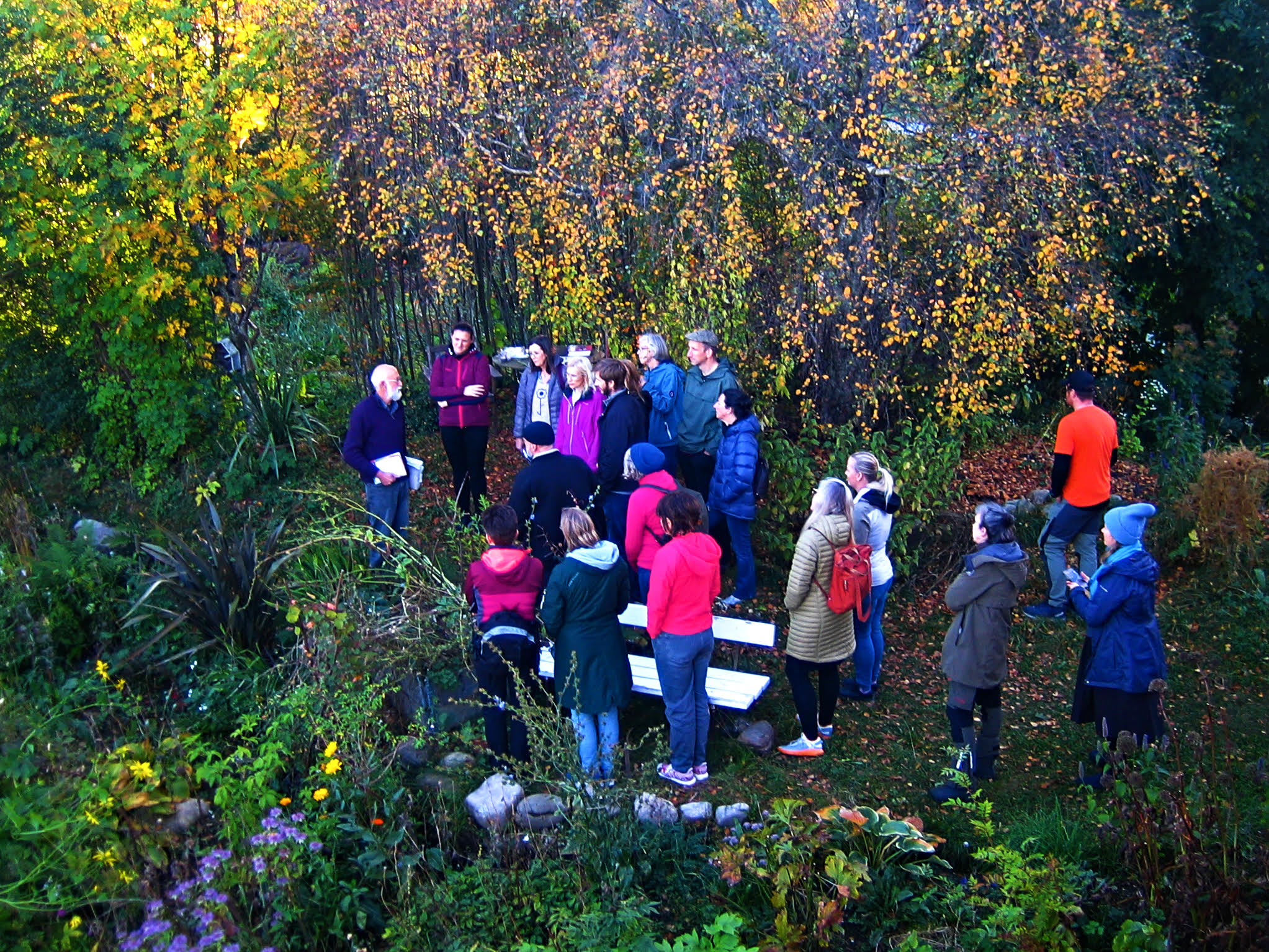
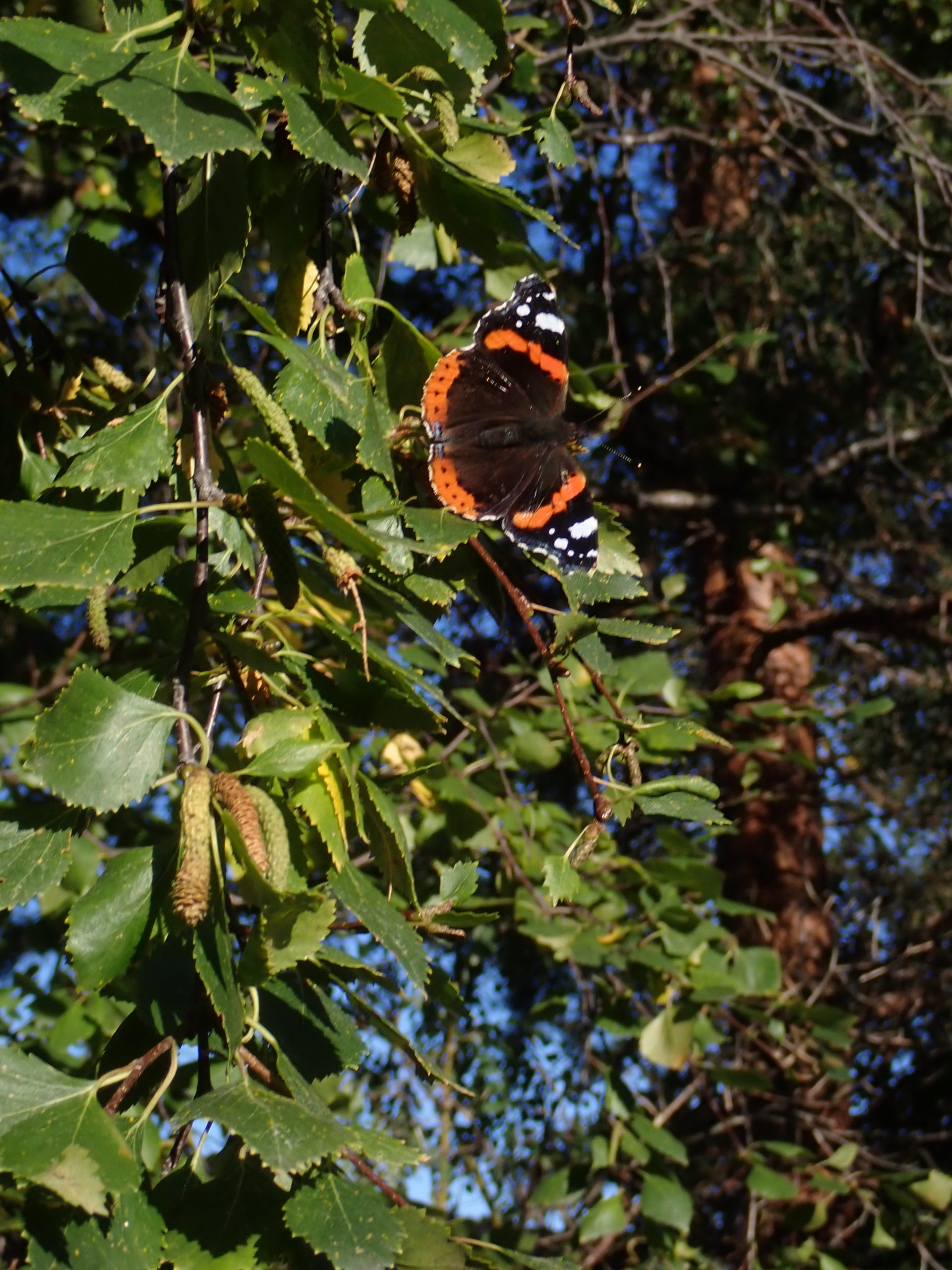
 Plant sale, perennial vegetables including many Alliums!
Plant sale, perennial vegetables including many Alliums!